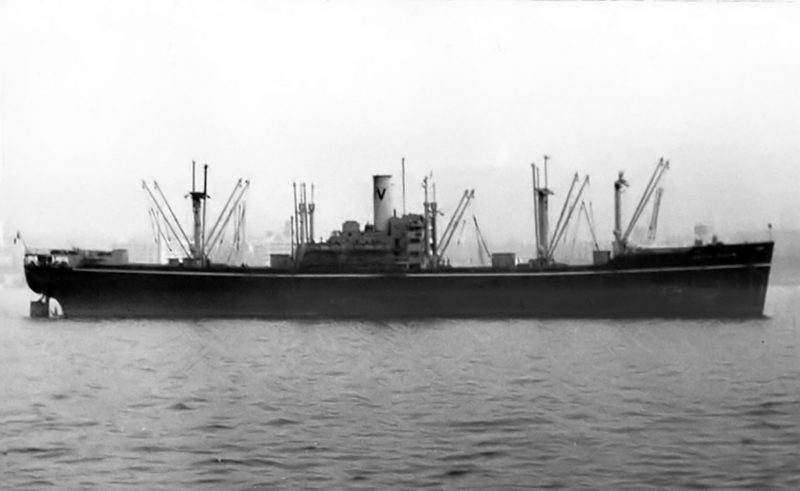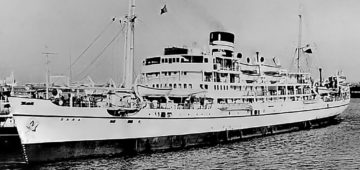
When it comes to assessing a ship’s value, two of my key criteria have always been uniqueness and aesthetics. So it is perhaps unsurprising that the ungainly Montserrat and Begoña, derived from that seemingly limitless supply of wartime Victory freighters, have never exactly set my pulse racing. Such ships rarely seem to warrant or receive special mention in any of the great works of ocean liner history and I’m probably not alone in being rather dismissive of their (Begoña in particular) cumbersome appearance, Spartan accommodation and seemingly dull careers. How wrong I was.
By the time these vessels were acquired by Compañíá Transatlañtica Española (the Spanish Line) they were unrecognisable from the five hold, three mast, one stovepipe funnel ‘Victories’ that had efficiently followed over 500 siblings down the production lines of six US shipyards. Driving each of them to a speed of 17 knots was a single steam turbine generating 6,600SHP comprising a set of High and Low pressure units. Montserrat started life as California Shipbuilding Corporation’s (Calships) yard number V63, a standard VC2-S-AP2 freighter laid down on 9th February 1945 at the company’s Los Angeles yard. Counter intuitively her power plant was built on the opposite side of the country by Allis Chalmers Manufacturing Co. in Milwaukee. Just fifty two days after the keel laying, on 2nd April 1945, she was launched as Wooster Victory (finally a name rather than a number) and before the end of the month was ready to sail on War Shipping Administration duties. The ship had taken a truly astonishing seventy five days from inception to completion. Almost simultaneously on the United States’ Eastern seaboard, another VC2-S-AP2 freighter was taking shape at the Bethlehem Fairfield yard in Baltimore, the ship that would ultimately sail as Begoña. Yard number 2471’s keel was laid on 19th March 1945 and she was launched as Vasser Victory on 3rd May, being completed, with a power plant built by the Westinghouse Electric Company of Pittsburgh on the 28th May, trimming a remarkable five days off her erstwhile sister’s completion time. By then the war in Europe was over and the focus of Allied effort had switched to the Pacific theatre.
In fact this pair ultimately shared the DNA characteristics of just 97 other ‘Victory Ships’, being adapted to carry as many as 1,597 servicemen. Wooster Victory was completed as a troopship in Los Angeles and sent immediately across the Pacific under the management of the General Steamship Corporation, whose funnel colours she bore, arriving in Melbourne on 29th May 1945. It turned out to be the first sector of a veritable maiden world cruise. From Melbourne she sailed to Calcutta, then headed across the Indian Ocean, calling at Lorenzo Marques (Mozambique), Port Elizabeth and Cape Town. From South Africa she sailed direct to Baltimore.
Vasser Victory was somewhat slower joining the fray. She had been assigned to Great Britain in one of the final acts of the Lend-Lease program and after calling at New York was officially handed over to the British exactly one year after D-Day. With the war drawing to its conclusion there was much less urgency surrounding her completion and by the time the conversion was finished the Japanese had surrendered. On 20th September, having been handed back to the American authorities, Vasser Victory departed for the French ports of Seine Est and Le Havre to load her first shipment of demob happy GIs. She would ultimately make eight roundtrips between Europe and the US east coast, two more than Wooster Victory. The latter finished her trooping duties in New York and was initially anchored at Hampton Roads. On 21st August 1946 she joined the James River reserve fleet and was offered for sale. After completing her own repatriation duties at Baltimore on 4th April 1947, Vasser Victory also headed for the James River.

In many ways these first voyages set the tone for the ships’ entire careers. Unglamorous, even austere they may have been, but they fulfilled a hugely important humanitarian role. Whether returning war weary soldiers to their homeland, or stateless refugees and migrants to promised lands, these two ships were a means of fulfilling that first step towards a new and potentially better life. They offered that most valuable of all commodities, hope.
It is now that one of the most illustrious names in shipping enters the story. Alexandre Vlasov was a Cossack of humble origins, who having worked for the Imperial government fled Russia during the post-revolutionary melee. He settled in Romania and progressively developed businesses in coal and shipping. In truth like so many of his generation Vlasov never truly settled, the shifting political landscape forced him to move on, first to Milan in 1938 and then when Italy entered the war in 1940 to Switzerland, New York and ultimately Buenos Aires, taking Argentine citizenship in 1941. Throughout this period Vlasov’s portfolio of shipping companies grew, perhaps most famously with the formation of Società Italiana Transporti Marittimi S.A. (Sitmar) in April 1938.
The end of the war prompted one of the greatest human migrations ever witnessed. Meeting this seemingly insatiable demand tempted several established shipping magnates to take their first steps into the passenger trade. Alexandre Vlasov was one of them.
The problem was finding ships. So much tonnage had been lost during the war and a shortage of raw materials and infrastructure in the cash-strapped 1940s meant building afresh was rarely an option. The availability of cheap replacements became a priority. Fortunately those Liberty and Victory ship production lines had created a glut of superannuated vessels and The Merchant Ship Sales Act of 1946 provided the vehicle by which this redundant stock could be sold to meet demand.
Subscribe today to read the full article!
Simply click below to subscribe and not only read the full article instantly, but gain unparalleled access to the specialist magazine for shipping enthusiasts.






Comments
Sorry, comments are closed for this item